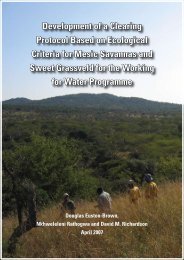Metsi Consultants - DWA Home Page
Metsi Consultants - DWA Home Page
Metsi Consultants - DWA Home Page
You also want an ePaper? Increase the reach of your titles
YUMPU automatically turns print PDFs into web optimized ePapers that Google loves.
Report No 678-F-001<br />
METSI CONSULTANTS: SUMMARY OF MAIN FINDINGS FOR PHASE 1 DEVELOPMENT<br />
consisting of both indigenous and exotic specis. Wildlife communities of Lesotho are highly distinctive with<br />
several endemic species but wildlife densities are very low due to heavy uncontrolled exploitation.<br />
The human population along the rivers downstream of the LHWP structures within Lesotho is about 155,000.<br />
Most of these people live in small villages, with a small proportion living in larger settlements such as Marakabei.<br />
Lack of formal education and high unemployment are characteristic of most communities. Rural people are<br />
heavily dependent on local resources for their livelihood, while foreign employment (South African mines)<br />
represents an important but declining source of income. Agriculture is an important source of livelihood but<br />
agricultural lands are constrained in size by topography and soil depths. Relatively more and better land is<br />
available along the Matsoku and upper Senqunyane Rivers than along the deeply incised Malibamats’o and<br />
upper Senqu rivers. Livestock are abundant in the study area (estimated populations of 68,000 catttle, 78,000<br />
sheep, 131,000 goats and 24,000 horses and donkeys). Nutritional levels of local people, especially children, are<br />
low, even by Lesotho rural standards, and there is a high incidence of childhood infectious diseases as well as<br />
water-borne diseases.<br />
3.2. STUDY SITES<br />
Within the broad study area, the areas addressed have been delineated according to the needs of the social and<br />
biophysical portions of the study.<br />
3.2.1 River Reaches<br />
The following reaches comprised the main area for the IFR determination:<br />
Malibamats'o River downstream of Katse Dam (LHWP Phase 1A) to the confluence with the Senqu<br />
River.<br />
Matsoku River downstream of the diversion weir (LHWP Phase 1B) to the confluence with the<br />
Malibamats'o River.<br />
Senqu River from the confluence with the Malibamats'o River to the Lesotho/RSA border.<br />
Senqunyane River downstream of Mohale Dam (LHWP Phase 1B) to the confluence with the Senqu<br />
River.<br />
3.2.2 Definitions<br />
The following definitions have been applied.<br />
IFR sites: sites for the collection of biophysical data; IFR sites are ~1 km long sections of rivers that are<br />
considered representative of the river reach on which they are situated; IFR sites extend to<br />
the 1:100 year flood line on either side of the river; sites are selected on the basis of typical<br />
geomorphology, flow characteristics, riparian vegetation, proximity to a flow or water level<br />
gauging station, and proximity to road access.<br />
IFR reaches: lengths of river represented by each IFR site; reaches are defined by the locations of major<br />
confluences, geomorphology and degrees of habitat integrity.<br />
Social villages: units for the collection of sociological data; survey data are collected at the level of the<br />
household, while the villages define the geographical cover afforded by the social study.<br />
Clinics: units for the collection of public health data.<br />
12

















